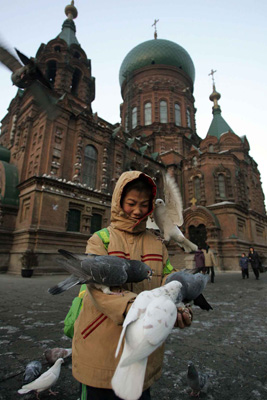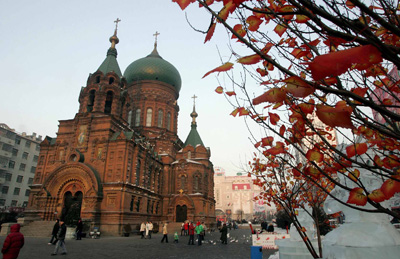South China Morning Post, March 28, 2005
Keeping the Faith
Despite centuries of secrecy, China's last Orthodox Christians are defiantly clinging to their beliefs in the hope of Beijing granting greater freedoms
By PAUL MOONEY in Beijing
Photos by Mark Ralston
For more than 300 years, the members of Beijing's small community of Orthodox Christians have tenaciously held on to their faith, withstanding anti-western Boxers who murdered 222 faithful in 1900, angry young Red Guards in the 1960s who drove the church underground, and the current economic boom that has scattered the faithful to far-flung corners of the city.
But the survival of their tradition now hinges on a single shipping container and a pile of wood from the Russian Far East gathering dust in a corner of the Russian embassy in Beijing.
The materials are intended for the construction of a sturdy wooden church for the local Orthodox community, a gift from fellow Orthodox Christians in Russia. But as Beijing's Religious Affairs Bureau dallies over whether or not to give the nod for the church to be built, the church pieces sit untouched, and Beijing's Orthodox community moves closer to extinction.
"There is not a single priest or place of worship for Orthodox Chinese in Beijing," says Dimitry Napara, a Russian businessman living in Beijing who is active in the Russian Orthodox Church. "We hope the authorities will decide very soon."
Because it is not one of the five officially sanctioned religions in China - Buddhism, Taoism, Protestantism, Catholicism and Islam - the Orthodox Church technically cannot train priests or hold services on the mainland, and the younger generation of offspring from Orthodox Christian families are fast losing their faith.
Father Dionisy Pozdnyaev, director of the Study Group on Orthodox Affairs in China, says Orthodox believers have been in limbo since the mid-1960s.
 "They have not been able to experience church life for four decades," says the Russian priest, a frequent visitor to Beijing. "They have tried to practise in their homes, but it's not been possible.
"They have not been able to experience church life for four decades," says the Russian priest, a frequent visitor to Beijing. "They have tried to practise in their homes, but it's not been possible.
Du Zhonglian, who also goes by the name Victor Dubinin, the name of his Cossack ancestor who arrived in the Chinese capital nine generations ago, sits in a fast-food outlet in the north of Beijing telling his story as he sips tea. Despite three centuries of intermarriage with the Chinese, Mr Du's face still bears slight traces of his Russian ancestry.
He says that aside from his faith, his only other vestige of Russian culture is the colouring of Easter eggs and baking paskha, a Russian cake eaten at Paskha, or Easter. When asked if he meets with other members of the Orthodox community to practise his religion, Mr Du replies firmly: "I won't do anything illegal." Asked if he still prays at home, he responds simply: "In my heart."
Mr Du says that Orthodoxy in China dates back to the 1600s, when the Manchus fought against Russian Cossack settlements along the Amur River in the fortress town of Albazin. The city fell to the Chinese in 1685 and Cossack captives - including Mr Du's ancestor - were taken to Beijing as prisoners, where Emperor Kang Xi made them members of one of the Manchu military banners. The Albazinians were given quarters in the grounds of the God of War Temple in the northeastern corner of the imperial city, and the temple was converted into St Nicholas the Wonder-worker Church.
In its first 150 years, the church did not attract many local followers, but in the second half of the 19th century, Orthodoxy made great strides with the arrival of scholarly clergy and the translation of religious texts into Chinese.
The numbers swelled in the wake of the Russian revolution, when anti-Bolshevik Russian emigres poured across the border into China in 1917. There were 106 Orthodox churches in China in 1949, and tens of thousands of believers. But when the communists came to power that year, there was a Russian exodus. No one knows how many remain scattered around the country today. Father Dionisy says about 12,000, but adds: "They are very secluded and separated communities."
In 1956, Soviet leader Nikita Khrushchev ordered the church dedicated to the Holy Dormition, which sat on embassy grounds, to be shut down, and it was partially torn apart and turned into a garage. A year later, the Orthodox Church in China was declared autonomous, with Chinese bishops named in both Beijing and Shanghai. But its autonomy did not last long. With the launch of the Cultural Revolution (1966-1976), religious believers were persecuted, arrested and tortured, church property was seized and all activity was halted or driven underground.
Mr Du, 66, says the Albazinian community was forced out of its homes in 1966, and its members scattered around the city. He remains bitter about this event, even though it took place almost four decades ago. He reaches into his pocket and pulls out a detailed sketch of the area. He carefully spreads it on the table and begins pointing to various landmarks: the former homes of family and friends, the bishop's residence, the old Orthodox Church.
"All Orthodox Chinese went to liturgy there on Sundays," Mr Du recalls. "We lived there for generations." The area fell to the wrecking ball in 2002, making way for high-rise complexes.
Attempts to revive the Orthodox Church began slowly in the 1980s, as China began to open up, and the Moscow Patriarchate joined Chinese believers in lobbying for permission to register churches.
The situation varies from place to place depending on the attitudes of local religious bureaucrats. In some areas, Russian priests have been allowed to quietly cross the border to serve the spiritual needs of Orthodox Christians, as religious officials look the other way. Some also turn a blind eye to small groups of believers practising quietly in their homes. However, one Russian priest was deported from Xinjiang province in December 2003.
 The Protection of Our Lady in Harbin was the first church to reopen, offering Church Slavonic services for the handful of remaining Russian refugees and Chinese faithful. Father Gregory Zhu Shipu, the last priest to serve the community there, died in 2000. Meanwhile, in Harbin, the beautiful St Sofia Cathedral was renovated and opened as a museum in 1997.
The Protection of Our Lady in Harbin was the first church to reopen, offering Church Slavonic services for the handful of remaining Russian refugees and Chinese faithful. Father Gregory Zhu Shipu, the last priest to serve the community there, died in 2000. Meanwhile, in Harbin, the beautiful St Sofia Cathedral was renovated and opened as a museum in 1997.
Another 3,000 Orthodox Christians live in Xinjiang, and in 1986 were allowed to reconstruct their church in Urumqi. But with no priest, the community can only meet to pray. The two remaining clergy on the mainland, Father Michael Wang and Protodeacon Evangel Lu, still live in Shanghai, but are too old to conduct services.
Two old Orthodox churches in the city have been transformed into a restaurant and karaoke bar. The Russians have been lobbying to have the buildings converted to more respectable use, but have met strong resistance from the current occupants.
An estimated 100 to 300 Orthodox Christians reside in Beijing today - mainly the descendents of the early Cossacks, but they have no way to practise their religion, and requests made since the late 1980s for permission to register remain unanswered.
Christmas liturgy was celebrated at the Russian embassy in Beijing in 2002 and about 50 Albazinians attended, despite a ban on Chinese attending foreign religious services. It was the first chance in more than 40 years for the group to attend a liturgy, and some had tears in their eyes. Chinese officials expressed displeasure, and the invitation was not repeated.
Father Alexander Du Lifu, the last remaining Orthodox priest in Beijing, died in December 2003 without realising his dream of reopening a church in Beijing.
Meanwhile, the Russian Orthodox Church continues to work hard for the revival of Orthodoxy in China. Eighteen young Chinese men and women are studying in Russia now, the men preparing for the priesthood, the women being trained as choir leaders and icon painters. One of the seminarians is to be ordained soon, but it's still unclear if he - or other seminarians - will be allowed to return to serve the community. "We have to negotiate with the authorities," says Father Dionisy. "We think they will be allowed to come back. They know we are teaching them."
Over the past five months, Russian Bishop Mark came to Beijing at the invitation of the Religious Affairs Bureau. Also, Russian President Vladimir Putin is believed to have raised the issue during a visit to Beijing last October.
Attempts are also being made to grow the church in cyberspace. Mitrophan Chin, a young Chinese-American who converted to the Orthodox religion, now volunteers as the webmaster for www.orthodox.cn , which was launched last year.
Mr Chin, who took the name of a priest who was one of those martyred in 1900, predicts that the Chinese Orthodox Church "will change, but not disappear", and he believes survival may lie in a new generation of Chinese believers. "The converts will have a greater zeal to spread Orthodoxy because they embrace it and want to practise it, and not because they inherited it," he says. Meanwhile, requests for permission to register in Beijing remain unanswered, and the reason is not entirely clear. Some say that with just a few hundred members, the Orthodox community is too small. Others point to the highly conservative nature of Beijing's Religious Affairs Bureau. Russians feel the local community may not be trying hard enough.
Father Dionisy and other Russians are pinning their hopes on the new legal provisions on religious affairs that came into effect on March 1, pointing out that they do not specifically mention the five recognised religions. "The regulations are changing and we expect a change in the attitudes of the authorities," he says.
But experts say this may just be wishful thinking. "The registration requirements remain very strict in the regulations, which in fact are the main feature of the document," says a western expert on Christianity in China. "The Orthodox Christians will probably be disappointed because all religious groups must register. No exceptions."